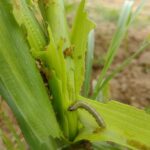In the agricultural world, few enemies are as feared and as common as the fall armyworm (Spodoptera frugiperda), a pest that can wreak havoc on a wide variety of crops. This article aims to provide a detailed insight into how to identify and effectively manage this agricultural threat, crucial for ensuring the health and productivity of your crops.

Identification and Characteristics of the Fall Armyworm
The fall armyworm is a versatile and destructive pest, known for its ability to adapt and resist various control methods. Originating from the tropical and subtropical regions of the Americas, this lepidopteran has spread to numerous countries, becoming a global problem for farmers. The larva of Spodoptera frugiperda, the most damaging stage of its life cycle, voraciously feeds on the leaves and stems of plants, particularly affecting crops such as corn, rice, sorghum, and cotton.

Control and Management Strategies for the Fall Armyworm
Identifying the presence of fall armyworm early is key to effective management. Signs of their activity include the appearance of small holes in the leaves and the presence of their characteristic green or brown larvae. Additionally, it is important to pay attention to their life cycles and migration patterns, as these can vary depending on the region and climatic conditions.
Biological Control: Use of Natural Enemies
Regarding fall armyworm control, there are several strategies that can be implemented. One of the most effective methods is biological control, which includes the use of natural enemies such as parasitoids, predators, and pathogens specific to this pest. Another option is the use of pheromones to disrupt mating and reduce pest populations.

Insecticides: Chemical and Organic Options
However, in cases of severe infestations, it may be necessary to resort to insecticides. The use of chemical products should be carried out responsibly, following the recommendations of experts and local regulations to minimize environmental impact and avoid the development of resistance in pests. Alternatively, organic and natural insecticide options can be explored, which are less harmful to the environment and beneficial insects.

Integrating Methods for Effective Management
Constant Monitoring and Integrated Management
Constant monitoring and the implementation of integrated pest management are fundamental to effectively combat the fall armyworm. This includes combining different control methods, adjusting them according to the specific conditions of each crop and geographical area.

In conclusion, fall armyworm management requires a holistic and adaptive approach. Staying informed about the latest research and control strategies is crucial to protect your crops from this persistent and adaptable pest. By implementing integrated and sustainable management, you will not only be protecting your harvest but also contributing to the health of the agricultural ecosystem.
Insecticides to eliminate the fall armyworm (Spodoptera frugiperda)
Below, we provide a top five list of insect icides authorized by the GENERAL DIRECTORATE OF PLANT HEALTH of Mexico for the control of Spodoptera frugiperda in corn cultivation
Cypermethrin
- Commercial name: CYPERMETHRIN 200
- Recommended dosage: 250-300 mL/ha
· Lambda-cyhalothrin + Chlorpyrifos Ethyl
- Commercial name: LATIGO-L
- Dosage not specified in the document for this product
· Lambda-cyhalothrin
- Commercial name: KARATE ZEON 5 CS
- Dosage not specified in the document for this product
· Methomyl
- Commercial name: MATADOR 90 PS
- Recommended dosage: 300-400 g/ha
· Azadirachtin
- Commercial name: NEEMIX 4.5
- Recommended dosage: 0.244-0.777 L/ha
Additionally, although not in the top 5, the document also mentions other insecticides such as Emamectin Benzoate (RINGO) and Flubendiamide (BELT), with recommended dosages of 100-400 mL/ha and 0.075-0.10 L/ha, respectively.

It is important to highlight that the use of these insecticides should be carried out following specific dosage and application recommendations to ensure effectiveness and minimize environmental and health impacts.
 AgronoBlog – Agriculture Blog
AgronoBlog – Agriculture Blog 